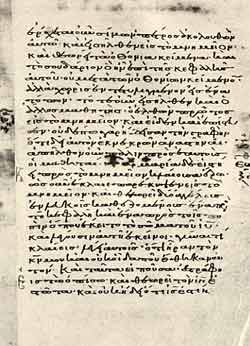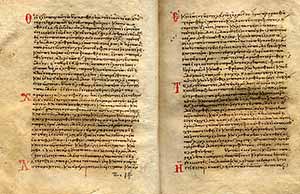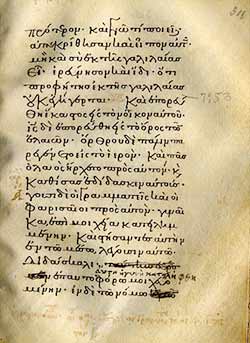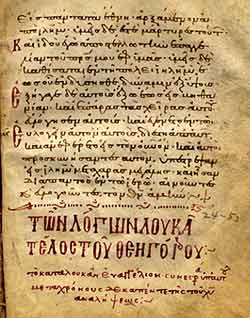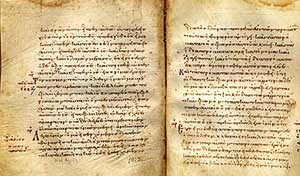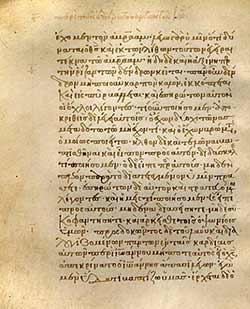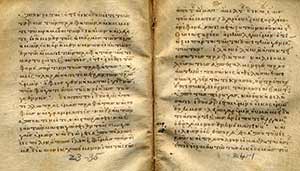The Gruber Rare Books Collection and Other Rare Books
New Testament Manuscripts: Gospels
All of the following manuscripts were photographed by The Center for the Study of New Testament Manuscripts in 2010. Copies of these photographs are available on a website: http://www.csntm.org/manuscript. Click on "Manuscripts" on the left hand of the screen and look for the appropriate Gregory-Aland number.
Gregory-Aland 1282. This 12th century manuscript of the Four Gospels is 246 folios long, but folios 239-246 and 231-238 were reversed in the process of binding. The pericope dealing with the woman taken in adultery (John 7:53-8:11, folio 214 reverse and 215 obverse).
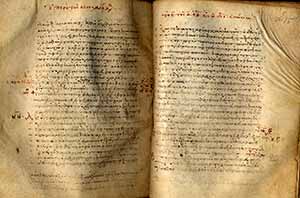
is marked with asterisks, meaning that users of this manuscript thought that this passage was an interpolation and not an original part of John’s Gospel (note that it is lacking in most ancient authorities and printed within double brackets in the NRSV). On folios 118 reverse and 119 obverse this manuscript also contains the longer ending of Mark (16:9-20), including the extra word “Amen” at the end of v. 20, which is mentioned only in the apparatus of Nestle Aland. The text shown on the left of this page is John 20:5-14, folio 245 obverse.
Gregory-Aland 2304. This 13th century manuscript of the Four Gospels is 234 folios long, but two folios are missing. It contains four badly flaked miniatures of the evangelists (28v, 85v, 125v, 187v). The text shown on the left of this page is Luke 7:6-23, folio 142 reverse and 143 obverse.
Also shown below are scans of the longer ending of Mark (folio 122 reverse and folio 123 obverse)
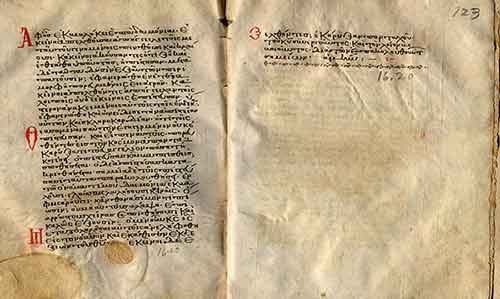
and the pericope dealing with the woman taken in adultery (John 7:53-8:11, folio 205 reverse and 206 obverse)
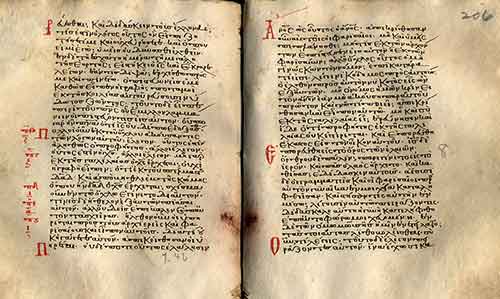 .
.
Scholars judge both passages to be secondary and they are not included in the best manuscripts.
Gregory-Aland 2426. This 13th or 14th century manuscript of the Four Gospels is 362 folios long. Four miniatures of the evangelists, slightly flaked, are on 10 reverse, 111 reverse, 177 reverse, and 287 reverse. The picture shown here is of the evangelist Luke, folio 177 reverse

The text shown on the left is from John 7:51-8:5 (folio 318 obverse), including the pericope of the woman taken in adultery.
Gruber 119-120-54. Greg.-Dob. 2389. Four Gospels. 11th-12th centuries (Gruber 1050). These three manuscripts were acquired at different times and from different sources, and Dr. Gruber has performed a genuine service in reuniting them.
Gregory-Aland 2389. This copy of the Four Gospels has 201 folios, with Mark (Gruber 119), Luke (Gruber 120), and John (Gruber 54) bound separately. The manuscript was written by the monk Nikolaos whose name appears in a full-page cruciform uncial colophon Gruber 119, 52 obverse and also in Gruber 54, 61 reverse. The text shown on Gruber 119 is Mark 7:20-26, folio 21 reverse, on Gruber 120 Luke 24:47b-53, folio 86 obverse, and on Gruber 54 John 9:35b-10:10a, folio 30 reverse.
Gregory-Aland 2388. This 13th or 14th century manuscript of the four gospels is 230 folios long, with illuminations on 1r, 66r, 107r, and 173r. Acquired by Gruber in 1920. The text shown on the left is Luke 3:8-16, folio 114 reverse.
Gregory-Aland 1826. This 13th or 14th century fragmentary manuscript of the four gospels is 24 folios long and contains Matt 20:19-26:59; John 13:3-17 (after Matt 26:20) and Luke 22:43-45 (after Matt 26:39). The citations from John and Luke may show lectionary influence. The remaining 57 folios of this manuscript are in St. Petersburg, Russia. This manuscript was acquired by Gruber in 1920. The text shown on this page is Matt 23:29-24:1 (folio 11 reverse and 12 obverse)
For more details on these manuscripts see Kenneth W. Clark, A Descriptive Catalogue of Greek New Testament Manuscripts in North America. Chicago: The University of Chicago Press, 1937, pp. 90-106.
The Gruber Collection was assembled by L. Franklin Gruber, President of Chicago Lutheran Theological Seminary, Maywood, Illinois.
Annotation prepared by Ralph W Klein
